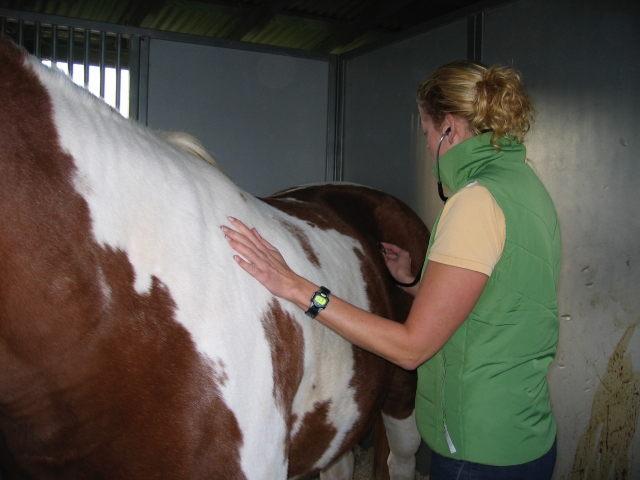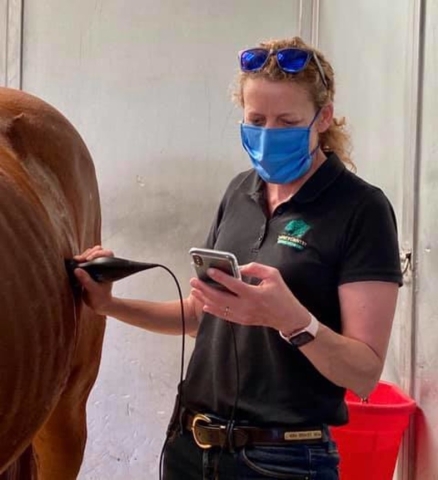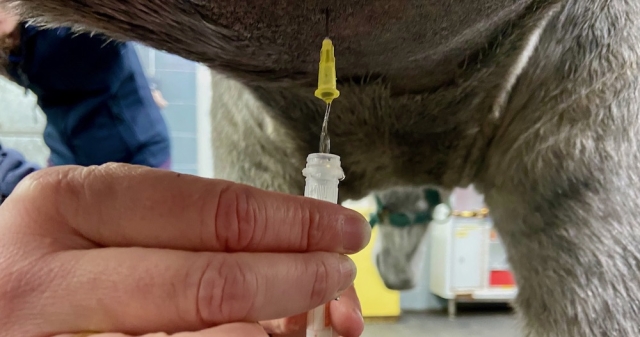 A physical exam is still one of the veterinarian’s best methods of diagnosing colic. // Photo by Nora Grenager.
A physical exam is still one of the veterinarian’s best methods of diagnosing colic. // Photo by Nora Grenager.
Equestrians dread few things like they dread a colicky horse, and for good reason.
Colic, of course, simply means abdominal pain in the horse, and it can stem from a wide range of causes, including an impaction, gas colic, a twisted gut or some other rare problem. In addition to the danger it poses to the horse, it’s also a frustration for horse owners that, despite a wide array of modern technology, vets can’t just look inside the horse to determine the problem. Colic is still a puzzle, and the only way to know with 100 percent certainty what’s going on is to open the horse up surgically. Because of these limitations, there are two very important things to remember when dealing with colic: trust your vet’s detective skills, and don’t let your desire for full and perfect knowledge prevent you from acting quickly on the knowledge you do have.
Why we can’t see
One of the technologies that is sometimes used in the diagnosis of colic is a focused abdominal ultrasound called a Fast Localized Abdominal Sonography of Horses (FLASH) exam. According to Melinda Freckleton, a veterinarian at Firestar Veterinary Services in northern Virginia, this ultrasound can image several areas of the abdomen for particular signs of colic-related problems.
“This can be done in about 5 to 10 minutes and gain a lot more information about what might be wrong,” Freckleton said.
However, it can’t see everything, and it is the horse’s own anatomy that causes these limitations.
“The horse’s abdomen is so big and deep that ultrasound cannot penetrate enough to reach every inch – except in a small foal,” Freckleton said. “This means there is still a ‘black box’ in the center that we can’t see. The part we can see is around the outside edge, donut shaped – with a mystery portion in the middle. There isn’t a technology with large enough focus to look at every square inch and deep inside the horse’s barrel.”
A human can be put through an MRI or CT scan, but there are none big enough in a veterinary clinic to view the middle of the horse, let alone in the veterinarian’s truck.
“Owners need to realize we are always working with an incomplete data set,” Freckleton said. “The only way to look at the abdomen all the way through is to go to surgery.”
The many diagnostic tools
In the absence of one perfect diagnostic tool, vets use many, and one of the greatest tools – regardless of what they have in terms of technology – is the physical exam.
“What the horse tells us is more important than lab results and imaging technology,” Freckleton said. “No matter how well equipped any vet is, he/she will start with a physical exam.”
Basic things like temperature, heart rate, capillary refill time, and the horse’s comfort level are important starting data points to understand what is seen with any technology.
“Sometimes when I get there to examine the horse, and start to take its temperature, the owner will tell me he/she already took temperature,” she said. “But I always do it again because it may have changed, and I take the heart rate again. If they can tell me what it was a few minutes ago or an hour ago, their original data point is useful, and my doing it again doesn’t mean I don’t believe them or that they were wrong. I want to see how it’s changing, and what it is right now.”
The basic colic exam generally includes a rectal exam. By feeling and touching the organs within reach rectally can give important clues as to what might be wrong.
“I am still astonished at how many owners think that we are just taking the ‘poop’ out when we do a rectal exam – pulling out some manure,” she said. “Someone might say, ‘He just pooped a minute ago,’ and I remind people that I’m taking the manure out just to make room for my arm, so I can directly feel all the organs within reach. It’s the same as when you are on an examination table and your doctor is pushing on your belly. The doctor is feeling where all the organs are, their size, and whether it hurts when they are touched.”
“After that, we might use some other things to help us.
“Passing a nasogastric tube is often done – both as a treatment and a diagnostic,” she said. “Since horses can’t vomit and most of them don’t burp, you can get excess fluid back out of the stomach with the tube. Sometimes just letting excess gas out can make the horse feel better.”
 While they can be useful, ultrasounds are an imperfect diagnostic tool, as they can’t show the deepest parts of the horse’s abdomen. // Photo by Nora Grenager.Some horses are able to burp gas, but others can’t.
While they can be useful, ultrasounds are an imperfect diagnostic tool, as they can’t show the deepest parts of the horse’s abdomen. // Photo by Nora Grenager.Some horses are able to burp gas, but others can’t.
“Saddlebreds probably burp more frequently than some breeds, but they can’t all burp and they can’t always burp,” she said.
Today many veterinarians also bring lactate meters when they come to check a horse, something that came into use within the last five years.
“We just take a drop of blood from the horse, and it’s similar to a glucose meter that people use to check their blood sugar level,” Freckleton said. “The lactate meter gives us a measure of tissue damage in the body. If it is super high, in a colic setting, we know tissue is distressed. The higher it is, the more tissue distress is occurring.”
In a very stoic horse that doesn’t give much sign of pain and distress, this tool can be very useful.
“Some horses are very stoic, and Saddlebreds tend to be more stoic than Thoroughbreds, for instance,” Freckleon said. “If a horse isn’t showing the big alert that it is in pain, you might not realize how serious the condition might be. A young Thoroughbred might be flopping on the ground in distress, and a middle-aged Saddlebred with the same kind of issue is just standing there looking a little dull – with a very quiet complaint. Thus, the lactate meter can be a very important tool. If your vet doesn’t have that tool, however, he/she still can use other important criteria.”
In some cases, diagnosis might also be aided with an ultrasound.
Being sure isn’t always best
No diagnostic method is perfect. However, even if one of them was, waiting for something like an ultrasound isn’t always the best course of action.
“If you are near a surgical center … and the horse’s signs are at a certain point, the veterinarian might recommend taking the horse there, if you are willing to do surgery,” Freckleton said. “Time is of the essence and the horse’s condition may deteriorate quickly and we don’t want to wait around.”
The initial examination of the horse at the farm may only take 10 or 15 minutes for an experienced veterinarian, and the suggestion of surgery that quickly may come as a surprise to the owner.
“We can get enough data in that short exam, however, to know that for the best outcome of the horse, they need to transport now,” Freckleton said. “I remind people that this suggestion does not mean their horse absolutely needs surgery; it means that if it does, to get a good surgical outcome, the horse needs to be where a surgeon can do it at a moment’s notice if and when the horse gets to that point.”
If you wait too long to make the decision, the horse may not be able to travel, and travel time is part of the equation.
“If you wait until I know 100% that your horse needs surgery, you are losing valuable time, and losing tissue; some of it is dying,” Freckleton said. “Sometimes an owner protests the idea of surgery at this point and asks if we can ultrasound or do some other lab test to prove it. The answer is yes, I can. I have an ultrasound machine on the truck and I could also do a belly tap – abdominocentesis – and get more information. But I don’t need that information to know that your horse needs to be in a surgical center.”
Of course, surgery isn’t needed in every colic case.
 Vets may sometimes perform a belly tap when diagnosing colic, but waiting to do a belly tap or ultrasound may not be the best idea, depending on your horse’s other signs. // Photo by Nora Grenager. “Some are just happy mysteries,” Freckleton said. “We never know what caused the problem, but the mystery is no longer an issue because the horse feels fine; the discomfort has passed. Whatever was wrong resolved. It can be hard to be at peace with that – not knowing the cause – and I understand why owners might still want to know, but that’s the state of the technology we have today. We do have a lot more technology now, however, than we had 10 years ago, or 30 years ago, and can do a better job of diagnosis.”
Vets may sometimes perform a belly tap when diagnosing colic, but waiting to do a belly tap or ultrasound may not be the best idea, depending on your horse’s other signs. // Photo by Nora Grenager. “Some are just happy mysteries,” Freckleton said. “We never know what caused the problem, but the mystery is no longer an issue because the horse feels fine; the discomfort has passed. Whatever was wrong resolved. It can be hard to be at peace with that – not knowing the cause – and I understand why owners might still want to know, but that’s the state of the technology we have today. We do have a lot more technology now, however, than we had 10 years ago, or 30 years ago, and can do a better job of diagnosis.”
It's important for owners to know that colic surgery itself has also evolved and is no longer the risk it was in the past.
“We have come a long ways in the past 25 years,” Freckleton said. “Most horses survive it and many can come back from it and become excellent athletes. It’s important to talk about this realistically, because not every colic surgery is the same. Owners need to talk with the surgeon regarding their expectations and what this horse will be able to do. Colic surgery can give you a fabulous athlete back again, or a mare that can still be bred.”
Freckleton has seen this firsthand.
“In my own barn I have a horse that went from colic surgery when he was a second level dressage horse, and afterward went on to become an FEI level dressage horse,” she said. “The colic surgery was an unfortunate hiccup in his history but saved his life. He would not have survived the gut displacement, without it.”
Despite imperfect knowledge, when Saddlebred owners act quickly, their horses often go on to do the same.
“They are not in a career that only spans their youth – like racing or some other careers in which horses just have that early moment in time to make their mark,” Freckleton said. “With horses that have long careers, colic surgery is just a minor interruption. A Saddlebred can go on to be a park horse or a roadster or whatever division the owner was planning to do.”



